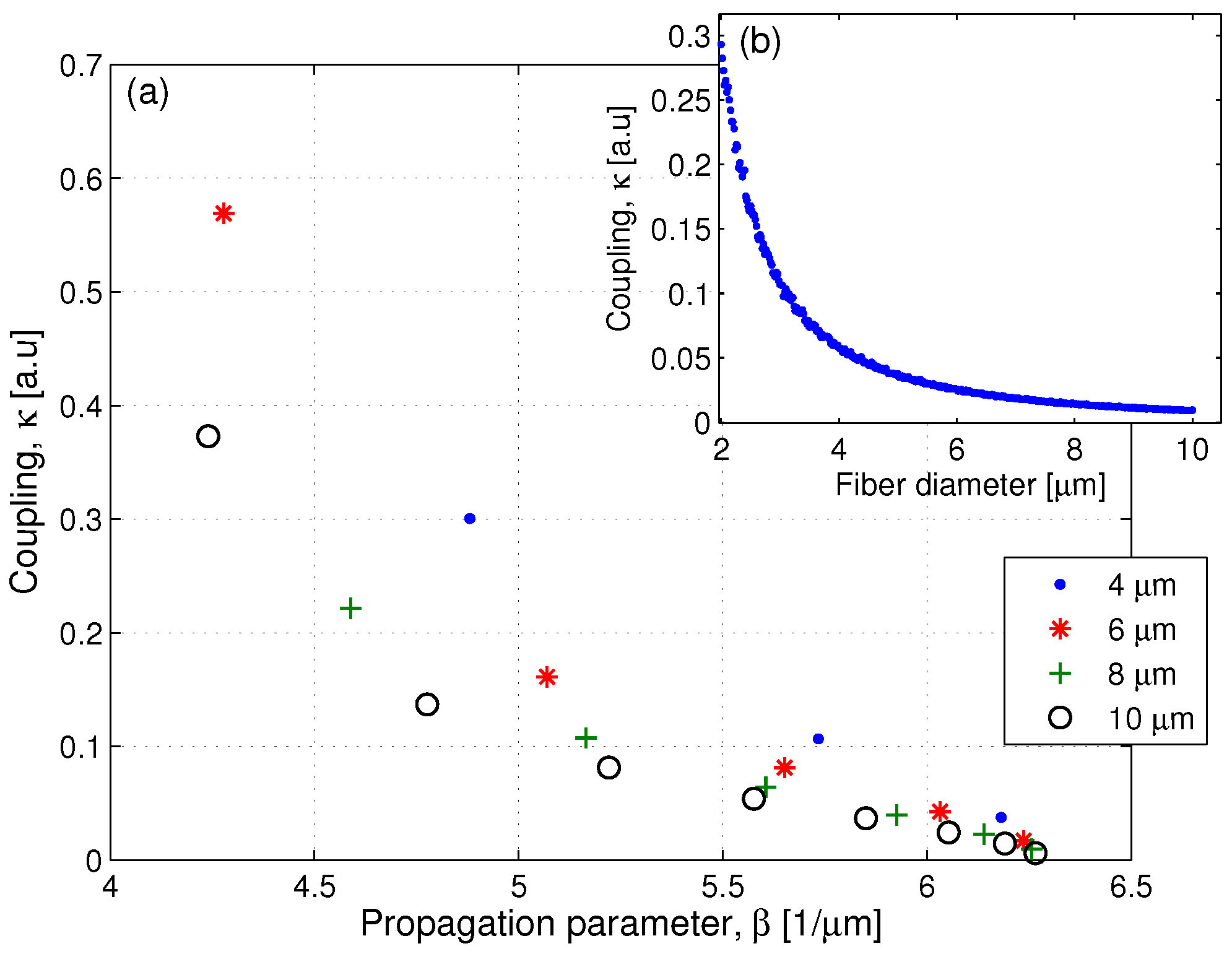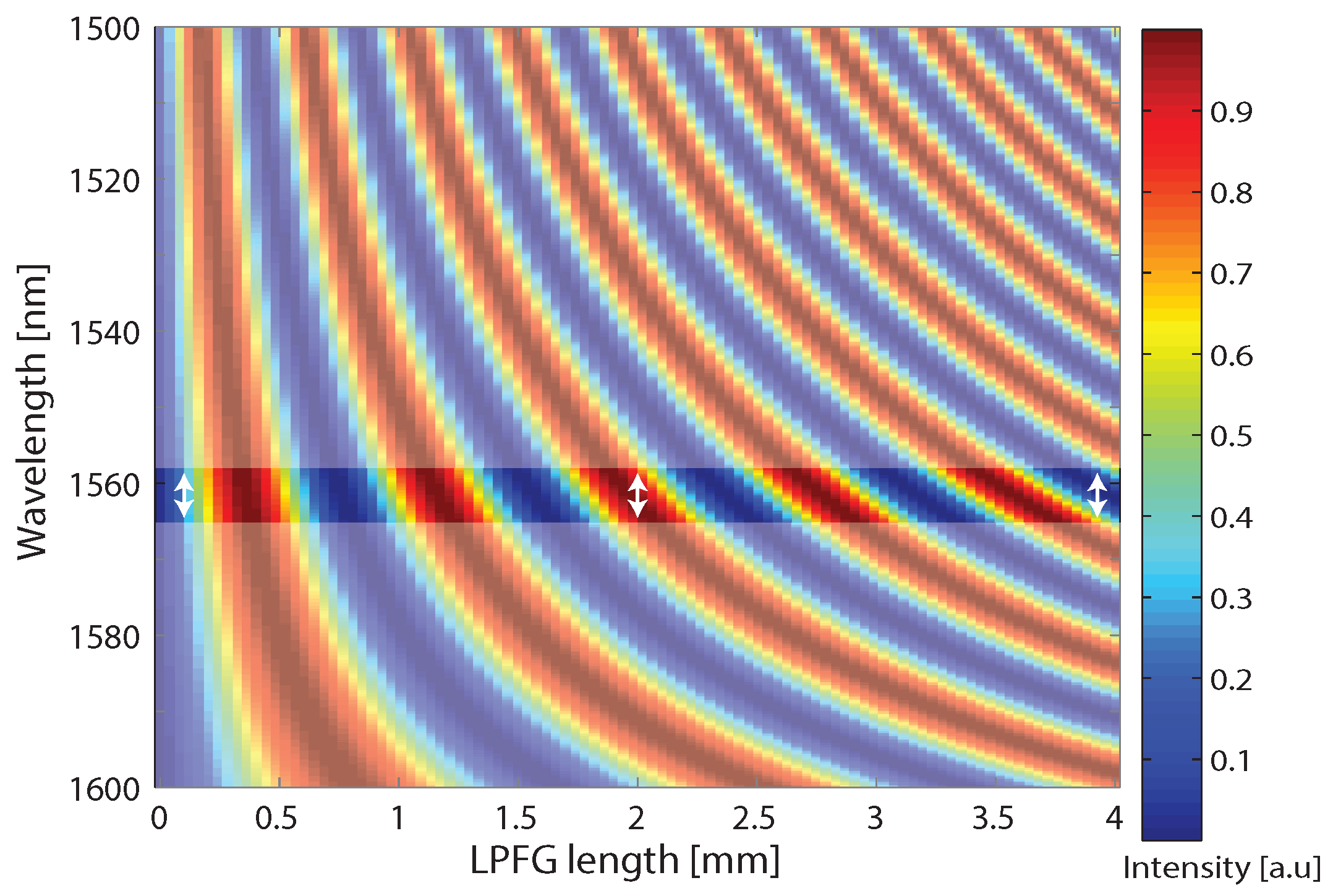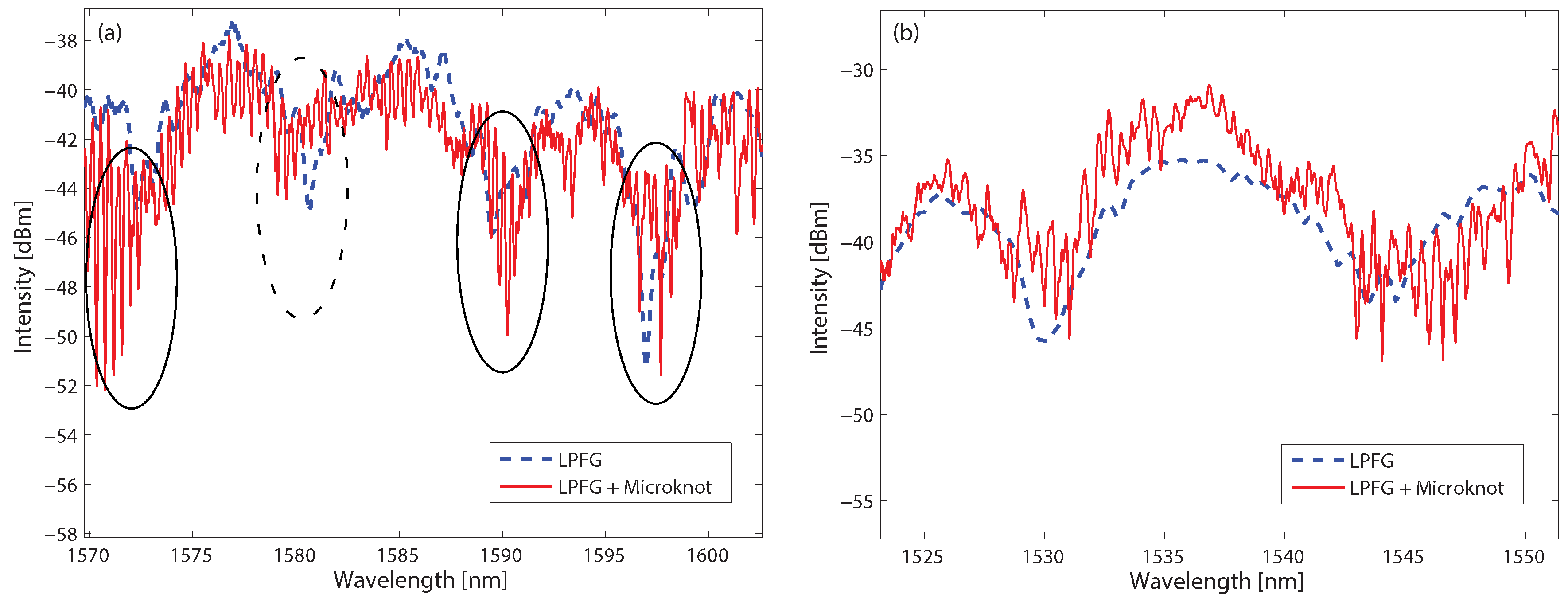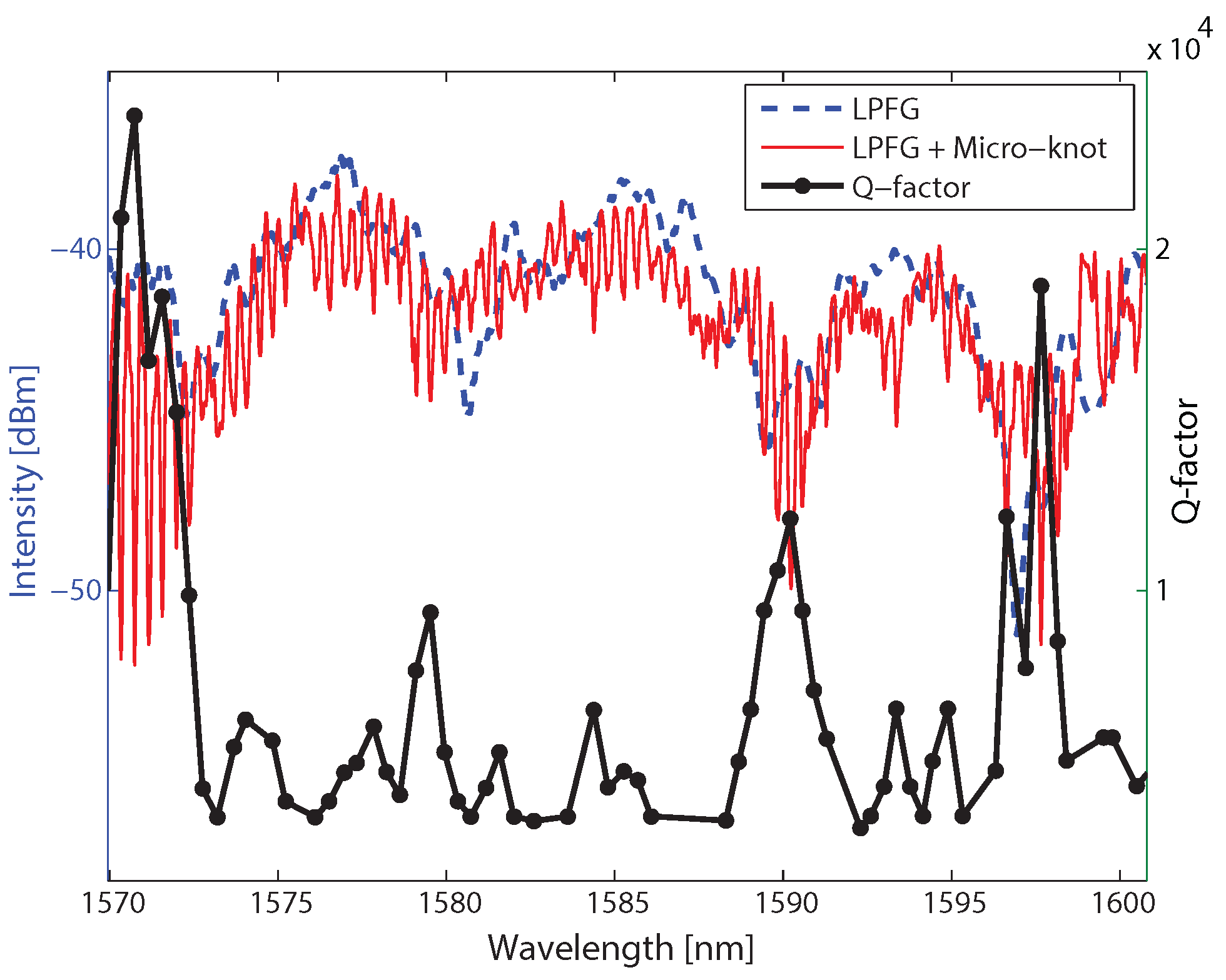High-Order Modes Micro-Knot Excited by a Long-Period Fiber Grating
Abstract
:Author Contributions
Conflicts of Interest
References
- Jiang, X.; Tong, L.; Vienne, G.; Guo, X.; Tsao, A.; Yang, Q.; Yang, D. Demonstration of optical microfiber knot resonators. Appl. Phys. Lett. 2006, 88, 223501. [Google Scholar] [CrossRef]
- Wu, Y.; Rao, Y.J.; Chen, Y.H.; Gong, Y. Miniature fiber-optic temperature sensors based on silica/polymer microfiber knot resonators. Opt. Express 2009, 17, 18142–18147. [Google Scholar] [CrossRef] [PubMed]
- Wu, Y.; Zhang, T.; Rao, Y.; Gong, Y. Miniature interferometric humidity sensors based on silica/polymer microfiber knot resonators. Sens. Actuators B Chem. 2011, 155, 258–263. [Google Scholar] [CrossRef]
- Wang, S.; Wang, J.; Li, G.; Tong, L. Modeling optical microfiber loops for seawater sensing. Appl. Opt. 2012, 51, 3017–3023. [Google Scholar] [CrossRef] [PubMed]
- Lim, K.; Harun, S.; Damanhuri, S.; Jasim, A.; Tio, C.; Ahmad, H. Current sensor based on microfiber knot resonator. Sens. Actuators A Phys. 2011, 167, 60–62. [Google Scholar] [CrossRef]
- Li, X.; Ding, H. All-fiber magnetic-field sensor based on microfiber knot resonator and magnetic fluid. Opt. Lett. 2012, 37, 5187–5189. [Google Scholar] [CrossRef] [PubMed]
- Wu, Y.; Zeng, X.; Rao, Y.J.; Hou, C.L.; Yang, G.G. MOEMS accelerometer based on microfiber knot resonator. In Proceedings of the 20th International Conference on Optical Fibre Sensors, International Society for Optics and Photonics, Edinburgh, UK, 5–9 October 2009; p. 75036U. [Google Scholar]
- Jiang, X.; Chen, Y.; Vienne, G.; Tong, L. All-fiber add-drop filters based on microfiber knot resonators. Opt. Lett. 2007, 32, 1710–1712. [Google Scholar] [CrossRef] [PubMed]
- Freitas, J.M.D.; Birks, T.A.; Rollings, M. Optical micro-knot resonator hydrophone. Opt. Express 2015, 23, 5850–5860. [Google Scholar] [CrossRef] [PubMed]
- Tong, L. Brief introduction to optical microfibers and nanofibers. Front. Optoelectron. China 2010, 3, 54–60. [Google Scholar] [CrossRef]
- Shahal, S.; Klein, A.; Masri, G.; Fridman, M. Fused fiber micro-knots. Appl. Opt. 2016, 55, 4538–4541. [Google Scholar] [CrossRef] [PubMed]
- Masri, G.; Shahal, S.; Klein, A.; Duadi, H.; Fridman, M. Polarization dependence of asymmetric off-resonance long period fiber gratings. Opt. Express 2016, 24, 29843–29851. [Google Scholar] [CrossRef] [PubMed]
- Shahal, S.; Klein, A.; Masri, G.; Duadi, H.; Fridman, M. Long period fiber gratings with off-resonance spectral response based on mechanical oscillations. J. Opt. Soc. Am. A 2017, 34, 264–269. [Google Scholar] [CrossRef] [PubMed]
- Dong, J.; Chiang, K.S. Temperature-Insensitive Mode Converters With CO2-Laser Written Long-Period Fiber Gratings. IEEE Photonics Technol. Lett. 2015, 27, 1006–1009. [Google Scholar] [CrossRef]
- Hsu, K.C.; Jhuang, P.J.; Chih, Y.S.; Lai, Y.; Chen, N.K.; Lee, C.L.; Lin, C. Spectral response of long period fiber grating based on tapered fiber with side-contacted metal grating. J. Lightwave Technol. 2010, 28, 1057–1063. [Google Scholar]
- Chan, F.Y.M.; Yasumoto, K. Design of wavelength tunable long-period grating couplers based on asymmetric nonlinear dual-core fibers. Opt. Lett. 2007, 32, 3376–3378. [Google Scholar] [CrossRef] [PubMed]
- Guan, B.O.; Li, J.; Jin, L.; Ran, Y. Fiber Bragg gratings in optical microfibers. Opt. Fiber Technol. 2013, 19, 793–801. [Google Scholar] [CrossRef]
- James, S.W.; Tatam, R.P. Optical fibre long-period grating sensors: Characteristics and application. Meas. Sci. Technol. 2003, 14, R49. [Google Scholar] [CrossRef]
- Bhatia, V.; Vengsarkar, A.M. Optical fiber long-period grating sensors. Opt. Lett. 1996, 21, 692–694. [Google Scholar] [CrossRef] [PubMed]
- Daxhelet, X.; Kulishov, M. Theory and practice of long-period gratings: When a loss becomes a gain. Opt. Lett. 2003, 28, 686–688. [Google Scholar] [CrossRef] [PubMed]
- Erdogan, T. Fiber grating spectra. J. Lightwave Technol. 1997, 15, 1277–1294. [Google Scholar] [CrossRef]
- Fabiny, L.; Colet, P.; Roy, R.; Lenstra, D. Coherence and phase dynamics of spatially coupled solid-state lasers. Phys. Rev. A 1993, 47, 4287–4296. [Google Scholar] [CrossRef] [PubMed]
- Fridman, M.; Nixon, M.; Ronen, E.; Friesem, A.A.; Davidson, N. Phase locking of two coupled lasers with many longitudinal modes. Opt. Lett. 2010, 35, 526–528. [Google Scholar] [CrossRef] [PubMed]
- Huang, W.P. Coupled-mode theory for optical waveguides: An overview. J. Opt. Soc. Am. A 1994, 11, 963–983. [Google Scholar] [CrossRef]





© 2017 by the authors. Licensee MDPI, Basel, Switzerland. This article is an open access article distributed under the terms and conditions of the Creative Commons Attribution (CC BY) license (http://creativecommons.org/licenses/by/4.0/).
Share and Cite
Shahal, S.; Duadi, H.; Fridman, M. High-Order Modes Micro-Knot Excited by a Long-Period Fiber Grating. Sensors 2017, 17, 2490. https://doi.org/10.3390/s17112490
Shahal S, Duadi H, Fridman M. High-Order Modes Micro-Knot Excited by a Long-Period Fiber Grating. Sensors. 2017; 17(11):2490. https://doi.org/10.3390/s17112490
Chicago/Turabian StyleShahal, Shir, Hamootal Duadi, and Moti Fridman. 2017. "High-Order Modes Micro-Knot Excited by a Long-Period Fiber Grating" Sensors 17, no. 11: 2490. https://doi.org/10.3390/s17112490



